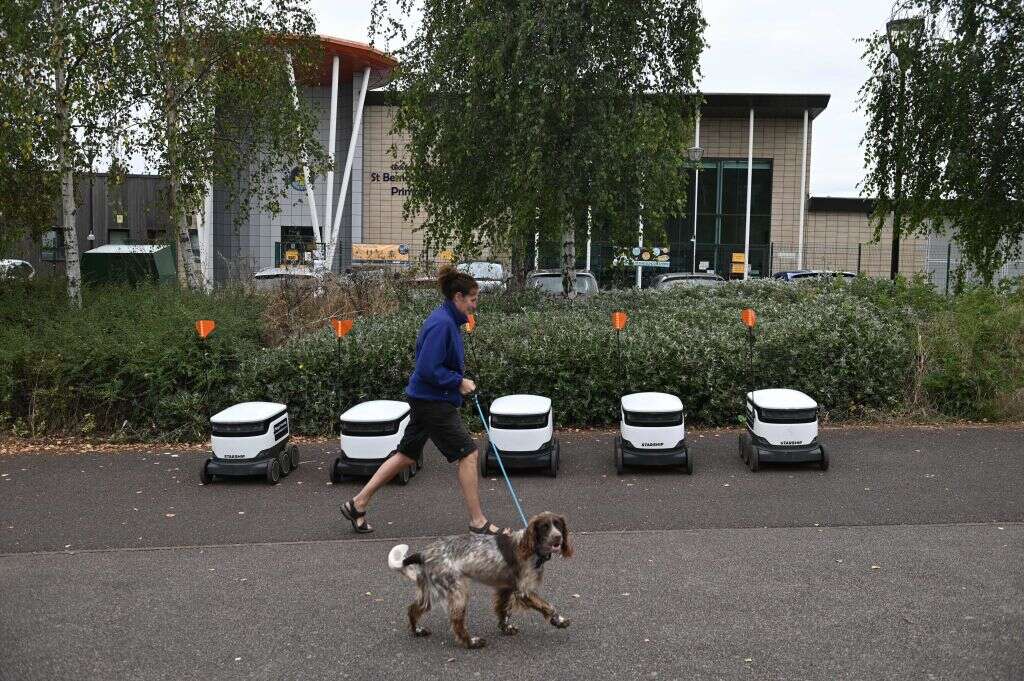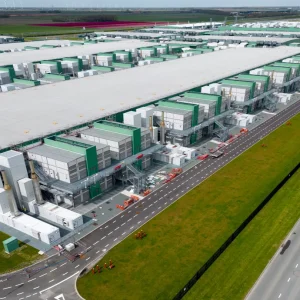
Life was not made easy for the UK’s earliest motorists. Until 1896, road traffic laws were designed to favour horse-drawn carriages and carts, so much so that their drivers were legally entitled to stop any automobile with a wave of their hand. For fear of their careening into bewildered pedestrians, motorised vehicles were also subject to a speed limit of 4mph and had to be preceded by a gentleman waving a red flag, a chivalrous complement to the guttural chugging of the internal combustion engine following behind.
A similar sight can be glimpsed in present-day Milton Keynes. Across the city, a fleet of almost 200 last-mile delivery robots can be found trundling along its pavements carrying groceries from Co-Op supermarkets to local residents. Operated by Estonian start-up Starship Technologies and roughly the size of a shopping basket with wheels, these machines are equipped with a bewildering array of cameras and sensors that allow them to be operated either autonomously or remotely. Their masters, however, prefer to err on the side of caution by capping their speed at a sedate 6mph. No one, however, needs to walk ahead of them waving a flag; the robot already has one.
Milton Keynes isn’t the only city to have been invaded by these trundling automatons. Companies including Amazon, DHL and FedEx have invested millions in pilot schemes for autonomous last-mile delivery robots in cities, suburbs and university campuses across Europe and North America. The benefits that come in deploying these fleets for customers, these companies argue, include faster and more predictable delivery times, not to mention fewer carbon emissions thanks to the reduction in logistics vans (less talked about are the potential labour savings made in also cutting their human drivers.)
Delivery robots have been greeted with a mixture of curiosity and bemusement by the general public. Accessibility advocates have repeatedly voiced concerns that delivery robots make it more difficult for wheelchair-using, visually impaired and deaf pedestrians to use the pavement safely. Others have pointed toward accidents involving robots, including machines being clipped or colliding with cars, run over by garbage trucks or nose-diving into canals, that suggest a troubling lack of situational awareness.
For Bryant Walker Smith, cases like these only serve to increase the impression that these robots are insufficiently regulated. “One of the refrains that I have pushed against many times in the context of automation generally, including with motor vehicles and, to a lesser extent, with sidewalk or pavement delivery robots, is this notion that there’s no law,” explains Smith, a law and engineering professor at the University of South Carolina.
The reality, says Smith, is a lot messier. In many of the jurisdictions where they’re operated, delivery robots are actually subject to municipal, state-level and national regulations that indirectly – and often ambiguously – address their conduct on pavements and sidewalks. As such, legislators and technology companies the world over are fighting to clarify the rules of the road (or, in most cases, the pavement) for these machines – decisions that could entirely transform the rights and responsibilities of not only pedestrians, but cyclists and motorists as well.

A pedestrian walks her dog next to a line of parked Starship delivery robots in Milton Keynes, September 2021. (Photo by Daniel LEAL / AFP)
Delivery robots and the law
Estonia has always accepted delivery robots, explains Thomas Hoffmann, who routinely sees Starship robots trundling round the Tallinn University of Technology. “People are rather proud that we have these kinds of things, and they don’t see them as an obstruction,” says Hoffmann, a law professor at the institution.
One of the beneficiaries of this attitude has been Cleveron. For the past one and a half years, the logistics company has operated its own delivery robot, the Cleveron 701, on roads around the city of Viljandi. The firm has also collaborated closely with potential competitors such as Starship and the Estonian authorities to adapt the country’s traffic codes for the arrival of delivery robots. “The technology is in the state where we feel safe going onto the street,” says Mihkel Ilp, a business development manager at Cleveron. More of a concern, says Ilp, is “the legislation that doesn’t really consider these types of vehicles on our public roads.”
The technology is in the state where we feel safe going onto the street.
Mihkel Ilp, Cleveron
It’s an issue that has confronted Cleveron as it conducts trials elsewhere in Europe. While there is some EU-wide continuity on matters including data protection and product liability in the event of an accident, says Hoffmann, the rules of the road (and pavement) for delivery robots are far from harmonious. According to one survey of 20 European countries conducted by Pinsent Masons on behalf of Starship, only one – Austria – gives delivery robots explicit permission to operate. As such, tech and logistics companies have been busily negotiating exemptions to these regulations to permit small-scale pilot schemes.
This situation is often referred to as ‘soft law,’ wherein flexible guidelines informed by constant communication between companies and local or national authorities reign instead of immutable regulations. Such is the arrangement in the UK, where Starship’s deployments are confined to a handful of cities under the watchful eye of the Department for Transport, and in Germany, where the firm successfully negotiated exemptions to traffic ordinances in Dusseldorf and Hamburg. It is a similar situation in many sites across the US, explains Walker Smith. “That’s why a lot of these deployments have been small-scale in limited areas, often on campuses,” he explains.
Increasingly, however, statehouses are proactively passing explicit statutes on delivery robot operation. Over the past decade, at least 20 US states have passed such laws, often after close consultation with companies like FedEx and Amazon, and without much public fanfare. According to Smith, it’s in the interests of these firms to lobby for as much leeway as possible in operating its robots. Perhaps unsurprisingly, many of these new regulations are more “principles or frameworks than legal codes,” he says.
This has both virtues and flaws, says Smith. The choice of states like Pennsylvania, for example, to simply extend the rights enjoyed by pedestrians toward delivery robots means that when accidents do occur, it’s easier to use “all of the existing law that has developed over decades” in that context to determine liability. Nevertheless, the lack of federal authority on this issue has led to a patchwork of diverging rules at the state level. Pennsylvania, for example, is one of two states where the maximum speed limit for a robot on the sidewalk is 12mph (roughly three times the average walking speed.) Meanwhile, in Maryland it is 7mph and in Washington 6mph.
These bills have also proven controversial among industry observers, says Smith, not least because they invariably contain provisions that overrule the authority of local municipalities and lead to new codes out of touch with realities on the ground. Such was the concern of local accessibility advocates in Pittsburgh, who feared the Pennsylvania law could lead to robots blocking wheelchair users from effectively using the city’s narrow sidewalks, as happened to a student at the local university in 2019.
Similar concerns were voiced by cyclists in Austin, Texas, aghast that delivery robots operated by Refraction AI were permitted to operate on bike lines. “I almost feel like we’re the test subject for this new technology,” said Jake Boone, then vice-chair of the Austin Bicycle Advisory Council. “What if in two years we have several hundred of these on the road?”

An Amazon Scout robot. The company is one of a number piloting robotic delivery services across the US and Europe. (Photo by Amazon)
A new standard for delivery robots
Bern Grush feels a similar sense of foreboding. For the past three years, the Toronto-based executive director of the Urban Robotics Foundation has looked on aghast at the haphazard way in which new regulations on delivery robots have been implemented across North America and Europe. Now, he says, “we're going to add an unaccompanied machine to a space that is intended for pedestrians, that is supposed to be designed for accessibility.”
It’s a prospect that led Grush’s home city of Toronto to ban delivery robots late last year, a decision he considers to be predictable but not the ultimate solution. What’s needed, he argues, is regulatory clarity, which is why he and a small team of four experts have been working on a new, internationally recognised ISO standard for such autonomous vehicles. Grush hopes that the guidelines will not only help legislators plug holes in existing statutes on things like braking distance, insurance coverage and even how delivery robots should cross the street, but also provide a clear template for countries looking to pass their own laws on the issue.
Consequently, ISO/4448 contains over 120 data definitions on weight, size, speed and cybersecurity, as well as more nuanced guidance on issues like direction of travel, the desirable shy distance between the robot and pedestrians (both walking and standing), the lights and sounds it should make to alert deaf and blind people to its presence, and scheduling systems for multiple deliveries. All of these points and more have been written in close consultation with more than 100 groups and individuals, including city planners, accessibility campaigners and legislators. Grush also wants the major tech companies operating delivery robots to have their say. Their response has been muted.
“The few that are aware of it are saying, 'Well, you know when the standard is done, we'll just use it. Let us know when it's done,’” says Grush. Efforts to secure sponsorship from UPS, FedEx and DHL have also failed, money that Grush claims would allow him to hire another couple of experts and speed up work on the standard’s raw text (without it, he predicts ISO/4448 will be ready by 2025 at the earliest.) Most importantly, it would allow these firms input on what is likely to become one of the most influential standards out there on delivery robot operation.
“I want you to write this in your article,” says Grush. “In order to prevent this clown from Toronto from doing this, can FedEx and UPS put their experts on this team and make damn sure this thing works!”
Even so, Grush isn’t alone in attempting to formulate an accepted international standard, or at least set precedents for one. Last year, the US National Highways and Transport Safety Authority published advice on how delivery robot operators could skip safety tests before commercial deployment. Meanwhile, the EU Commission has proven willing to fund investigations into precisely how the machines should operate on European roads – including one with Cleveron Mobility.
For his part, Ilp believes more regulatory clarity is essential. After all, it makes good business sense. “I think it’s very positive that organisations and people are working on these new regulations and consulting with the industry,” he says. “We are happily sharing our experiences and thoughts and, hopefully, this will lead us to a point where it’s easier for countries and authorities to review a product and allow it to go to market.”
While it’s fairly straightforward for most current operators to tweak the capabilities of their robots to comply with rules in different jurisdictions, it’s not hard to imagine demand increasing for some measure of legal uniformity as more companies enter the market. What remains to be seen is how that push will consider the concerns of pedestrians to reach an equitable middle ground between their needs and those of logistics firms – a future that avoids not only robots zooming past our feet at breakneck speed, but also the modern-day equivalent of someone walking slowly in front of these new contraptions, madly waving a red flag.






